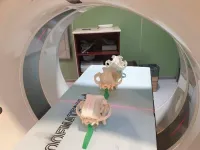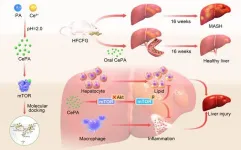(Press-News.org) A study combining history, economics, and fluvial geomorphology examines the causes of the adoption of coal power during the Industrial Revolution in Great Britain. At the beginning of the mechanization of the textile industry in Britain, most machines were powered with waterpower. Eventually waterpower was replaced by using coal to make steam power and the causes of this shift have long been debated. One influential hypothesis has been that waterpower became scarce in the industrial heartland of northwest England during the early 19th century, as all available suitable sites were already fitted with watermills. To test that hypothesis, Tara Jonell and colleagues evaluated the availability of waterpower resources across mainland Britain during the water-to-steam transition, which spanned about 1770–1840. The authors used 19th century climate and meteorological observations as well as a cartographic mill census data as inputs to geomorphological flow-routing to estimate river discharge and waterpower potential. The authors conclude that on a national scale, waterpower remained significantly underutilized, but that at key local scales, such as the major cotton textile production region north and east of Manchester, sometimes called “Cottonopolis,” waterpower was scarce by 1838, if not earlier. According to the authors, limited waterpower should be considered one of the major drivers that encouraged the adoption of the use of coal for steam power by area manufacturers.
END
Waterpower scarcity and coal use during the Industrial Revolution
2024-07-16
ELSE PRESS RELEASES FROM THIS DATE:
Capturing carbon with energy-efficient sodium carbonate−nanocarbon hybrid material
2024-07-16
Industrial emissions are one of the main sources of climate change-inducing carbon dioxide (CO2). While adopting renewable and clean energy alternatives is one option for mitigating these carbon emissions, carbon capture technology is another solution to control CO2 emissions. In big CO2-emitting industries, such as cement, oil refineries, and thermal power plants, carbon capture technology can be easily applied to remove CO2 emissions directly at the source at a feasible cost and with low energy consumption. Different materials have been explored for CO2 capture in factories, including zeolites, metal−organic frameworks, natural minerals, alkalis, ...
Digital dog and cat skull database
2024-07-16
The ELTE Eötvös Loránd University is home to the skulls of more than 150 dog breeds and other animals. To make this unique collection accessible to all, researchers digitised the skulls of 431 dogs, cats and wild relatives. The database can be used for educational and research purposes.
Tibor Csörgő, a researcher at ELTE, has been collecting animal skulls for decades to teach anatomy to biologists. The shape of the skull varies considerably between species and breeds, especially in dogs, where, for example, greyhounds have long skulls and the now popular French bulldogs have rounded skulls.
A skull biobank ...
Breaking through silicon
2024-07-16
Overcoming Historical Barriers
Silicon, the cornerstone of modern electronics, photovoltaics, and photonics, has traditionally been limited to surface-level nanofabrication due to the challenges posed by existing lithographic techniques. Available methods either fail to penetrate the wafer surface without causing alterations or are limited by the micron-scale resolution of laser lithography within Si. In the spirit of Richard Feynman's famous dictum, 'There's plenty of room at the bottom', ...
A new study finds that early detection of miRNAs in maternal blood may offer the potential for predicting preeclampsia
2024-07-16
Preeclampsia (PE) is a significant contributor to the increase in maternal morbidity and mortality worldwide, with particularly alarming numbers in the United States, where it affects about 2–8% of pregnancies, resulting in premature birth with associated morbidities for their infants as well. A new study by researchers at UCLA Health finds that early detection of specific microRNAs (miRNAs) packaged in vesicles may offer the opportunity to predict preeclampsia in pregnant people before clinical symptoms manifest.
The study, led by Dr. Sherin U. Devaskar, MD, executive chair of the Department of Pediatrics ...
Recycled micro-sized silicon anodes from photovoltaic waste improve lithium-ion battery performance
2024-07-16
Researchers from the Qingdao Institute of Bioenergy and Bioprocess Technology (QIBEBT) of the Chinese Academy of Sciences have developed low-cost micro-sized silicon anodes from recycled photovoltaic waste using a novel electrolyte design.
Their pioneering work, published in Nature Sustainability on July 16, offers a path to more sustainable, low-cost, and high-energy-density batteries that could transform energy storage systems for electric vehicles and renewable energy applications.
Silicon anodes are favored for their ability to substantially increase the energy density of lithium-ion batteries compared to traditional graphite anodes but are hindered by significant volume ...
Current international poverty line a ‘misleading shortcut method’, say experts
2024-07-16
Billions of dollars in foreign aid could be spent more effectively if international poverty statistics were more accurate, according to new research led by King's College London.
Dr Michail Moatsos, a research fellow in the Department of International Development, says current methods for calculating the international poverty line lead to a skewed picture of how poverty is distributed across the world – and this is hampering attempts to eradicate it.
“Currently, international donors cannot prioritise their funds based on the best possible information and therefore funnel those funds to those most in need around the world. A $2.15 per day poverty line affords very different ...
Food aroma study may help explain why meals taste bad in space
2024-07-16
Scientists from RMIT University have led a world-first study on common food aromas that may help explain why astronauts report that meals taste bland in space and struggle to eat their normal nutritional intake.
This research, which is published in the International Journal of Food Science and Technology, has broader implications for improving the diets of isolated people, including nursing home residents, by personalising aromas to enhance the flavour of their food.
Previous research has shown that aroma plays a big role in the flavour of food.
The team in this study tested how people perceived vanilla and almond extracts and lemon essential oil changed from normal environments on ...
Weather experts discover new effect of storm - in a teacup
2024-07-16
Britain, prepare for deep depression: storms ruin tea.
A new study reveals that Storm Ciaran cut an invisible path of mayhem across southern Britain last autumn, destroying any possibility that 20 million people could have a proper cup of tea at breakfast.
The storm's record-breaking low pressure meant the boiling point of water was below the crucial 100 degrees Celsius required for a decent cuppa, meteorologists at the University of Reading have discovered.
In a study published today [Tuesday, 16 July] in the journal Weather, the scientists reported that water in Reading was boiling at just 98°C.
During the storm on the morning of November 2, ...
Sorry, I didn’t get that: evaluating usability issues with AI-assisted smart speakers
2024-07-16
With the rapid development of AI technology, voice-controlled smart speakers are becoming increasingly popular due to their convenience and ability to control compatible home devices. Despite the rise in use, smart speakers often do not have screens and little-to-none of the visual information feedback common to manually operated devices. This aspect complicates their usability, thus providing room for research and subsequent improvement.
As such, a research team led by Dr. Toshihisa Doi, a lecturer at Osaka Metropolitan University’s Graduate School of Human Life and Ecology, recruited 39 young adults (22 males and ...
Phytic acid-based nanomedicine against mTOR for metabolic dysfunction-associated steatohepatitis therapy
2024-07-16
Metabolic dysfunction-associated steatohepatitis (MASH) is one of the most common chronic liver diseases, primarily caused by metabolic disorders and systemic inflammatory responses. Although the incidence of MASH is gradually increasing, there is a lack of effective drugs and methods for its treatment, thus limiting therapeutic options for MASH. Professor Liu Lei's team has long focused on the treatment and molecular mechanisms of liver-related diseases. Due to cerium's significant antioxidant and anti-inflammatory activities, as well as its hepatophilicity and good biosafety, it shows great potential ...







